The Starkweather Chapel in Ypsilanti’s Highland Cemetery, for those of you who may not have noticed, has been undergoing some much needed renovation work this past year. Here, with more on the history of the building, and the preservation work that’s been done thus far, is a conversation I just had with lifelong Ypsilanti resident and troublemaker Barry LaRue.
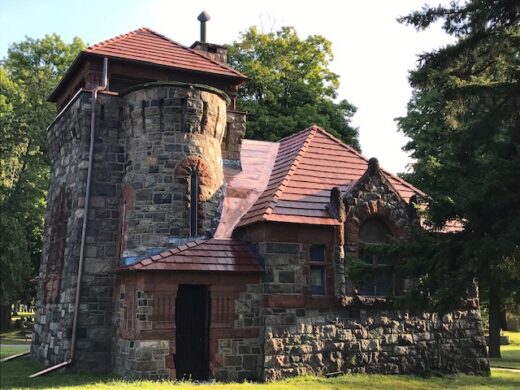
MARK: OK, before we jump in and start talking about the work you’ve been doing at the chapel, perhaps we could start by talking about the Starkweather family. Who were they, and why were they important relative to Ypsilanti history?
BARRY Well, John and Mary Ann Starkweather moved to Ypsi around 1841, when they bought 160 acres on the Huron River, on either side of Huron River Drive. Their Greek Revival home still sits on a parcel that was once part of the Starkweather farm and orchard, right across Huron River Drive from Cornell Road, at the edge of the EMU campus. John was appointed Assistant Superintendent of Public Instruction by Michigan Governor Stevens T. Mason in the same year of 1841. He assisted Reverend John D. Pierce in the laying out of the system of public schools for the newly formed state. John had married Mary Ann Newberry in Detroit, in 1839. We don’t precisely know what the Starkweather’s sympathies were toward slavery, but George McCoy, father of Elijah McCoy the inventor, lived on the Starkweather property, and was an active participant in the Underground Railroad. He assisted slaves in getting toward Detroit by hiding in the false bottom of a wagon he used to deliver tobacco.
MARK: Speaking of the Starkweather House, I have a piece of trivia that might be of interest. The fact that it’s still standing is due, in a roundabout way, to Playboy magazine… A friend of mine who used to live here made his money primarily by selling things on Ebay. Among his best sellers were Playboy magazines. And he went to an estate sale at the old Startweather home, because they’d advertised that, among other things, there would be Playboys. As it turns out, however, they’d intended to say “Game Boys” in the ad. Well, this friend of mine wasn’t happy, but, as he was incredibly interested in local history, he stuck around and talked with folks on the site. And, at some point during the conversation, he learned that there were plans to raze the house in a few days. So, the following day, when he was talking in front of City Council on some other matter, he brought up the fact that the historic Starkweather home was about to be demolished, which then led to immediate action being taken to stop that from happening. So, thank you, Hugh Heffner, pornography, etc.
BARRY Serendipity. It’s a marvelous thing.
MARK: It’s a bit of a tangent, but I have a question about that George McCoy story. I’ve heard that same story, about him smuggling escaped slaves into Detroit in a tobacco wagon with a false bottom, but I have no idea where it comes from. Do you know the genesis of that story? Did George write it down somewhere? Did his son, Elijah McCoy, include it an autobiography that I’m not aware of? Or is it just a local oral legend that’s been handed down over the generations? I have no reason not to believe it, but I’m curious as to the genesis of the story.
BARRY I’m afraid I don’t know the origin of that particular story. It certainly is a compelling one, but is it accurate? Who knows? Some ancestor of mine perpetuated the story that my great, great, great, great, great grandfather died as a “patriot drummer” at the Battle of Bunker Hill. No such record exists of it, or his service, so I suspect it was a fantasy on someone’s part.

MARK: So, when was the Starkweather Chapel built, and do you know the circumstances surrounding the decision to build it?
BARRY John died in 1883, and, shortly after, Mary Ann inherited a substantial sum of money as a result of the death of her uncle, Walter Loomis Newberry. Since she was a widow with no children, and quite active in the Ypsilanti community, she ultimately made the decision to donate significant funds toward worthy causes. Her most notable gifts were the cast iron fountain in front of the old Ypsilanti Saving Bank, Starkweather Hall at the Normal School, the donation of her home on Huron Street to become the public library, and the Starkweather Memorial Chapel at Highland Cemetery. Oh, and let’s not forget about Mary Ann’s contribution toward the erection of the Civil War monument in Highland Cemetery!
MARK: So what year would the chapel have been constructed?
BARRY 1888. It was completed and turned over to the Highland Cemetery board around May of 1889. The architectural firm that designed the chapel was that of Mason & Rice of Detroit, the preeminent design team of that era. They designed the 1887 Ypsilanti Savings Bank that now houses the City Hall as well as the Ainsworth Mill building just down the hill from City Hall that currently houses the Ypsi branch of the Bank of Ann Arbor. Mary Ann Starkweather’s attorney was involved with the Savings Bank and could have recommended Mason & Rice to her. Plus she may have been impressed with the design on her own. She did, after all, selected the Savings Bank as the backdrop to her fountain.
MARK: You’ve mentioned this fountain twice now, and I’m not sure what you’re talking about. Are you saying that there was a fountain somewhere on the corner of Huron and Michigan Avenue, where City Hall is now? The only downtown fountain I’m aware of is the one outside the old Post Office, where the downtown branch of the Ypsi Public Library currently resides.
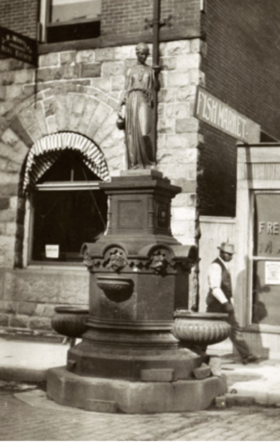 BARRY Here’s a photo. It was cast by the J.L. Mott Company. You could order various components out of a catalog and have them shipped to you via rail.
BARRY Here’s a photo. It was cast by the J.L. Mott Company. You could order various components out of a catalog and have them shipped to you via rail.
MARK: So what happened to it? Do we know where the statue is today?
BARRY The old story is that the water line died, and the City put it in storage for a while. Then it was put in Waterworks Park, sans the base. Eventually, though, all trace was lost… A sad end to a pretty nice piece of public art.
MARK: You mentioned Walter Loomis Newberry earlier. Should I recognize that name?
BARRY Probably not. He was into shipping early on. He moved to Detroit in the 1820s and then to Chicago, where he made his fortune in real estate and railroads. Half his estate funded the Newberry Library in Chicago. It’s a beautiful structure that is still a functioning reference library. I visited it several years ago, just to say I had. The other half of his estate was distributed after the 1885 death of his widow. When Mary Ann died in 1897, several shirttail relatives sued to get a share of her remaining estate, which took years to settle.
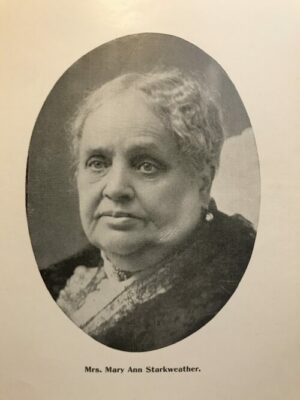 MARK: How did you come to be involved in the renovation of the chapel?
MARK: How did you come to be involved in the renovation of the chapel?
BARRY I was appointed to the Highland Cemetery board early in 2014. Bill French had resigned due to his serious health issues, and I took his seat. I’ve always found Highland to be a beautiful park-like setting, and the chapel a mysterious building that was locked up and little used. My father used to set up the sound system for the Memorial Day observances sponsored by the local American Legion post, and I’d tag along, usually wandering off into the cemetery. Years later, in 1983, when my mother died, I convinced my father and sister to have the final service in the Starkweather Chapel. It was dank and musty, but I really loved using it for its intended purpose.
MARK: So, what was its intended purpose? Was it intended solely as a place in which to host memorial services for the dead being buried at the cemetery, or was there a broader vision for the building when it was first conceived? Having never been inside, I don’t know the answer to this, but are there offices, for instance? Or was the Chapel intended to remain open to the public when not being used for memorial services?
BARRY It was built to provide a venue for memorial services. Prior to roughly 1900, the funeral home as we know it today didn’t exist. Local furniture stores were the ones who built caskets, and those who owned their own homes large enough to accommodate a funeral would host them in the parlor. Those poorer people, or transients at rooming houses or hotels, needed a place to have a funeral. People would generally ask the furniture store if they could have a service in their back room. In Ypsilanti, it would have been either in the Mack & Mack Furniture Store on Michigan Avenue (where Spark East is now) or J.E. Moore’s Furniture Store (where Beezy’s is now). Once you had the funeral, either in the home, in a church, or in the back of a furniture store, you still desired to say a few words over the deceased at the cemetery. Most people would have attended a short service in a tent pitched over the plot. The chapel provided a nice alternative, especially in inclement weather.
MARK: One wonders if perhaps the folks at either Mack & Mack Furniture Store or J.E. Moore’s Furniture Store might have objected to the construction of the Chapel. I’m guessing not, but I suppose it’s possible that these back-room funerals brought in some additional revenue which might disappear with the new Highland chapel…
BARRY The well-to-do of Ypsilanti wouldn’t have been using their funeral services, only buying a casket. So I doubt if the furniture stores would have been bothered by it. The MacAndrew family (Mack & Mack), by the way, are all buried at Highland. Jay E. Moore and his family are also there.
MARK: How would you describe the condition of the chapel when you started work on it? I assume, if it was already dank and musty in ‘83, it was probably in pretty bad shape when you began the rehab.
BARRY It was usable in 1983, just a bit sad. The apse area, beneath the observation tower, had already deteriorated to the point that a “temporary” wall was constructed to hide the fallen plaster and rotted wainscoting. In the intervening years, though, the rest of the roof started leaking and two of the exterior doors deteriorated badly. The former “winter receiving vault” allowed critters to crawl up into the rafters and get into the chapel itself.
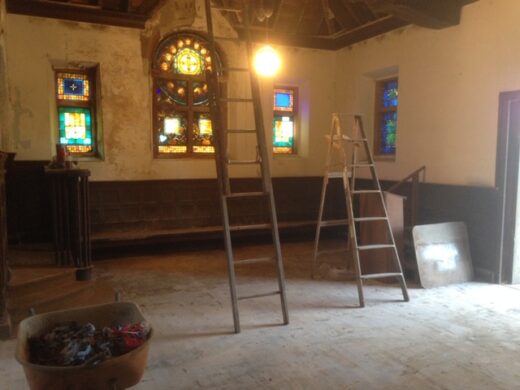
MARK: What’s a “winter receiving vault”? Is that where they’d leave bodies in the winter, when the ground was frozen?
BARRY Yep. There are pipe racks to hold the coffins. At that time the graves were dug by hand with shovels. When the ground was frozen you had to wait till spring. That’s where they would stack them. Problem was that the chapel vault is very small. You might only be able to jam five or six coffins in. Around 1905 or so, Daniel Quirk Sr. had a much larger receiving vault built. It was converted into a mausoleum in the 1960s, since, by that time, graves were dug using a backhoe, and it didn’t matter what season it was.
MARK: While we’re on the subject, I guess we should talk about the opening of Highland Cemetery, and what Ypsilantiians were doing with their dead prior to its opening… Speaking of which, when’s the last time human remains were found in Riverside Park?
BARRY Not Riverside Park, but Prospect Park. It’s my understanding that shortly after Highland opened in 1864 that a local gentleman was hired to start the process of disinterring graves on Prospect Street. It took almost 25 years, with one grave at a time being hauled to Highland in a horse drawn wagon.
MARK: Would I be right to assume that there was a heated debate over closing the cemetery on Prospect, and moving the bodies out of town? Or was everyone in agreement that the City needed to grow in that direction?
BARRY I think it was a combination of the fact that the Prospect Cemetery was virtually full and that housing was being constructed up to it. The other thing was that the upkeep was poor and the neighbors were complaining. Certainly there could have been a few lot holders who didn’t want to move Aunt Martha, but I think on the whole an artistically designed cemetery on the outskirts of town was considered a plus.
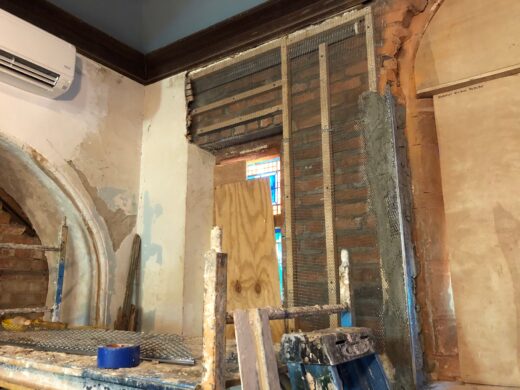
MARK: OK, so back to the condition of the chapel. In addition to the doors having deteriorated, the roof leaking, and animals having the run of the place, were there any other major issues that needed to be dealt with?
BARRY There was significant damage due to water intrusion. The observation tower originally had window openings with no sash. That allowed the rain and snow to come in during inclement weather. By the 1920s windows had been installed, but they failed to keep moisture from infiltrating the stone walls of the tower. As I mentioned earlier, all that was done was to erect that wall to hide the damage rather than trying to repair the underlying cause.
MARK: Was there a purpose for the tower, or was it just decorative?
BARRY I think it was always intended as a decorative architectural element. The spiral stairs to the observation room are extremely narrow. I doubt if Mary Ann Starkweather could have navigated it. Prior to the window installation, it would have given an excellent view of John and Mary Ann’s graves, and that of their dog “Watch.” There is a French door at the top of the stairs that is currently off its hinges. I intend to re-hang it with cast iron Victorian hinges. In any event, we have to be very cautious about people going up and down the stairs since I consider it a bit of a liability.
MARK: Wait, so they got to bury their dog at Highland? Would I be right to assume that Watch is the only non-human buried in the cemetery? One wonders how much of their philanthropic giving at Highland might have been motivated by the fact that they had a desire to be buried with their dog in violation of cemetery rules.
BARRY Well, we don’t know if Watch is actually under his memorial. Perhaps you could petition the Probate Court to have him exhumed…
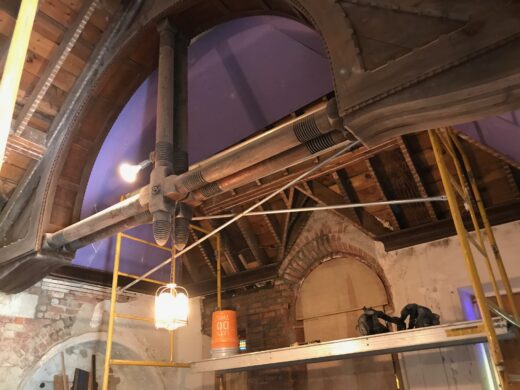
MARK: So, in terms of the tower area, they knew it was rotting, but instead of dealing with it, they just walled off the tower, so that the state of decay wasn’t noticeable…
BARRY Right. None of the folks responsible are still with us, so I don’t feel too bad pointing fingers. Past boards of Highland took a kind of “hands off” attitude about day to day functions and did little to encourage charitable donations. In the last several years we have reined in expenses and increased revenue to allow us to start to address the backlog of capital needs.
MARK: Anything else about the condition of the chapel when you started work on it?
BARRY Well, about ten years ago, there was a bee or wasp infestation in the rafters of the Chapel. A decision was made at that time to remove all the lath and plaster from the ceiling in order to deal with the problem.
MARK: So folks have known for a long time that significant work needed to be done…
BARRY Yes. As early as the 1990s Reverend Jasper Pennington from St. Luke’s Episcopal Church attempted to rally folks to preserve the cemetery’s assets. Then local architect Denis Schmiedeke started to lobby the Highland board to preserve the chapel and consider a nomination to the National Register. Around 2009, a Condition Assessment Report was done by Lincoln Poley, an Ann Arbor architect. It noted several of the issues I have mentioned above.
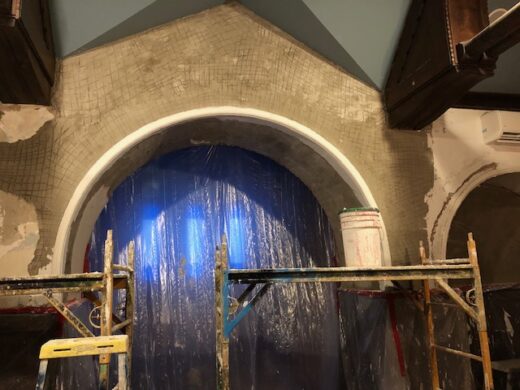
MARK: And, since then, it’s just been a matter of finding the money to deal with everything?
BARRY Yes. In 2016, working with DTE, we leased a small portion of the north end of the cemetery property for use as a solar array. With a 20 year lease, we finally had an income stream to assist Highland with unmet capital needs. Roads, water lines, the historic caretaker’s cottage and the chapel had all been underfunded, and we finally had the ability to speed up work on these important tasks!
MARK: Whose idea was it to reach out to DTE, or did they come to the Highland board?
BARRY DTE worked with the City to try to find public land to place the solar array on. They wanted the income to flow to the general fund. They steered DTE to the old dump site at I-94 and Huron, but DTE balked at using a contaminated site. Then they looked at public school property. That went nowhere. And that’s when they looked at a satellite map, saw the north end of the cemetery, and approached us. Dave Strenski at Solar Ypsi was super excited about our array going on-line as it raised the production of solar power in the City. I like it not only for the environment, and the income stream, but I also think it’s poetic that we have an example of current (no pun intended) technology helping us restore and maintain a really basic part of Ypsilanti’s history.
MARK: OK, so what’s been done so far to bring the chapel back to its former glory?
BARRY Well, in 2017, we updated the electrical service to the chapel by upgrading the buried underground cable and installing a circuit breaker panel. That would pave the way for being able to install up-to-date HVAC. Keeping the moisture level down will help to protect the plaster and wood surfaces as well as maintaining a comfort level appropriate for services and other activities regardless of season.
Then, in 2018, having arranged for a loan based on a portion of the DTE income stream, we hired a roofing contractor to begin tiling the chapel roof to match the original. The tile, from Ludowici in Ohio, arrived in the fall and the process of repairing the roof deck and applying ice guard begun. By the summer of 2019, the roof was complete, along with copper elements, such as gutters and downspouts.
This past August we moved to restoring the interior by drywalling the ceiling and painting it the original grayish-blue color. We found portions of the original ceiling and walls and subject them to chemical analysis by a local conservationist. As soon as the ceiling was done we contracted to have a ductless mini-split installed. This is a reversible heat pump that will allow both heat and air conditioning. Once that unit was installed we engaged a wet plasterer to repair the deteriorated brick walls.
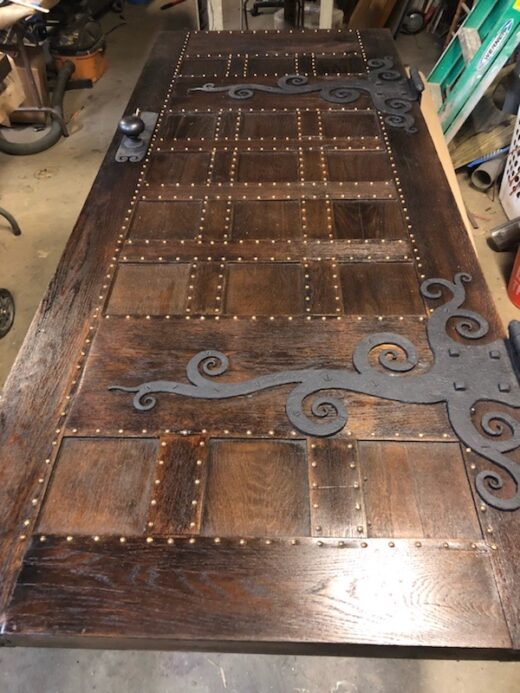
MARK: And that brings us to today?
BARRY Pretty much. Right now, we’re evaluating the wainscoting for touch up, and waiting for the plaster to cure in order to paint them the “ashes of rose” color. We still have a long way to go for a full restoration. The stained glass windows need conservation as does the exterior sandstone trim. Sandstone is very porous and when moisture penetrates it in the winter and it freezes the surface spalls and some pops off. This can be addressed with a European stone consolidant, but it’s a pricey concept that only specially trained artisans can apply properly. It can be sculpted to match the original design of each stone.
MARK: What can you tell us about the stained glass?
BARRY Well, the two large memorial windows are from Tiffany of New York City. I suspect that the rectangular windows flanking the memorial windows plus the two flanking the front doors are also Tiffany. I am less sure about the three Gothic inspired windows in the tower. Someone stole the lower two thirds of each of those windows around the 1960s. They were replaced with plain frosted sheet glass. In general, other than the missing sections, the windows are in remarkable condition given the lack of preventive maintenance over the years. We have a conservation studio with lots of experience lined up to do the work when we have raised the necessary funds.
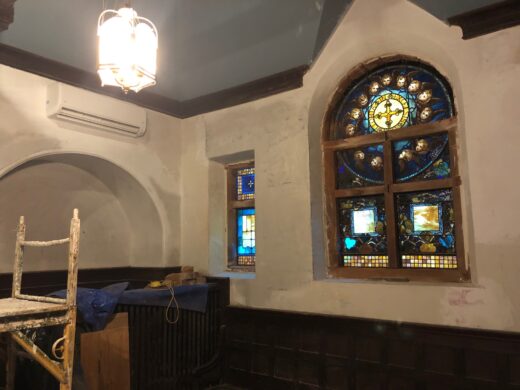
MARK: Any other things on the horizon at Highland?
BARRY Glad you asked! I mentioned Denis Schmiedeke. He did a great deal of research in an effort to craft a nomination to the National Register of Historic Places. He passed away in the fall of 2016. Eventually I recommended that we hire Robert Christensen, the retired National Register Coordinator for the State of Michigan Historic Preservation Office. He agreed to complete the application of the cemetery and handle research, photography and doing all the hand holding necessary to complete the process. As of December 2019, the application has passed both the Ypsilanti Historic District Commission, as well as the Historic Preservation Review Board in Lansing. It is now on its way to the Federal government for their approval. We should know in early 2020 that we have been listed. It is over 90 pages and is extremely well researched and has been praised for its quality.
MARK: How will inclusion on the National Register help?
BARRY Really the one major benefit is to be eligible for Grant in Aid through the State Historic Preservation Office. The plan is to apply for funding next fall toward either conservation of the stained glass or repair of the deteriorated sandstone. Those two items are the bulk of a “Phase Two” of the chapel restoration. The State funding is fairly modest so I am gearing up to do some fundraising in the spring to allow us to get things totally finished. I need some rest prior to my eternal rest…
MARK: Do you have a spot at Highland picked out? Is there a vacancy in the LaRue section?
BARRY My plot is on the parade route. As you enter the main gates, it’s on the left hand side, which aligns with my political views. Seriously, my parents are in the same plot with a large marker over all. As one of my co-workers told me years ago, “Barry, I really admire you. You’re a guy who knows where he’s going.”












4 Comments
This is fantastic! Thank you, Barry. I hope to see renovation of Starkweather Hall completed soon too.
You can read more about the solar panels in Highland Cemetery from this article my spouse, Paula Strenski, wrote for American Cemetery and Cremation Magazine.
SolarYpsi.org/CemCremArticle.pdf
Who knew there are a national magazine dedicated to Cemeteries and Cremations?
I was just thinking a few days ago as I reread one of your interviews Mark, that I hadn’t read any new ones in quite awhile. This is excellent. We are so thankful to Barry and the board and Tina at Highland Cemetery – our neighbor – for doing so much to continue making this a true garden Victorian resting place for so many souls. This is a wonderful article and the chapel is looking like new!
Great story. Glad to hear Barry’s name again, we were neighbors as kids.
2 Trackbacks
[…] of ours took a turn, and the dead started walking the earth. We started debating the merits of Starkweather Chapel, but ultimately decided that we’d try to make out way to Greenfield Village, which is already […]
[…] [Above, you can see what the finished tabletops look like today at Bellflower… Mark Maynard is a partner at Ypsilanti’s Bellflower restaurant. He also keeps an online journal where he writes, among other things, about Ypsilanti history. If you want to read more of him talking with Barry LaRue about Ypsilanti’s past, check out their recent discussion about Highland Cemetary’s Starkweather Chapel.] […]